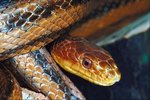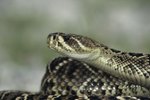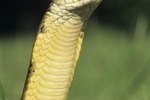
The Philippines is a tropical nation made up of more than 7,000 islands. The ecosystems found throughout the archipelago are prime habitat for a large number of snake species. While most of the snake species found there are harmless, the Philippines is also home to some of the deadliest snakes in the world. Venomous snakes in the Philippines fall into four categories.
Cobras

Easily identified by the intimidating hoods that extend on both sides of their heads, various cobra species inhabit the Philippines. The king cobra, the world's largest venomous snake, reaching a maximum length of 16 feet here. Three species of spitting cobras are native to the Philippines: the Northern Philippine cobra, the Southeastern Philippine cobra and the equatorial spitting cobra. In addition to inflicting deadly bites, these cobras have the ability to spit a blinding stream of venom at a target nearly 10 feet away.
Pit Vipers
These brightly colored snakes dwell in trees throughout the Philippines. Wagler’s, Philippine, Polillo, and Bataan are all different species of lance-headed pit vipers that inhabit the archipelago. A unique feature of lance-headed pit vipers is that they give live birth to their young instead of laying eggs. Pit viper venom attacks red blood cells instead of the nervous system like other snake venom.
Coral Snakes
Several species of coral snakes are found in the Philippines, including the Palawan long-glanded coral snake and the Luzon coral snake. Coral snakes are identifiable by their marking, which consist of multicolor bands or stripes. Primary nocturnal, coral snakes of the Philippines avoid dry areas and populate scrub jungles and monsoon forests. Coral snakes avoid human contact and are for the most part docile.
Sea Snakes
Many species of sea snakes, or kraits, inhabit the Philippine islands. Sea snakes must surface to breathe air,, but some can remain underwater for up to eight hours. Most live their entire lives in the water. They dwell among mangroves, rivers, lakes and streams; and a few can be found in the open ocean. Some species found in the Philippines include the yellow-lipped sea wraith, which is capable of producing up to 10 times the lethal dose of venom required to kill. The rare Lake Taal snake resides only in the volcanic lake for which the species is named and is one of the only sea snakes who live in freshwater.
Other Types
Many other types of snakes inhabit the Philippines. The reticulated python is one example. The python is a nonvenomous constricting snake who feeds on small mammals and can grow up to 30 feet. Long slender whip snakes, including the Oriental Whip Snake, reside in the forests of the Philippines. Wolf snakes, bronzebacks and flying snakes also call these islands home.
References
- CIA World Fact Book: Philippines
- US Army Public Health Command: Venomous Snakes of the Philippines
- Blue Planet Biomes: Wagler's Pit Viper
- Wild Asia: Yellow-Lipped Sea Kraith
- Animal Post: Reticulated Python
- Ecology Asia: Oriental Whip Snake
- Reptile Facts : Common Wolf Snake
- Ecology Asia: Painted Bronze Back
- National Geographic: Flying Snakes
Photo Credits
-
John Foxx/Stockbyte/Getty Images
Writer Bio
Currently living in Austin, Texas, Alexander Harris is a business journalist covering the self storage industry for SpareFoot.com and SelfStorage.com. Harris previously wrote daily news for RichmondBizSense.com, a business journal in his hometown of Richmond, Va. His work has appeared in various other publications including "Philadelphia Citypaper," Stateline.org, "RVA Magazine" and the "Virginian-Pilot." Harris holds a mass communications degree from Virginia Commonwealth University.




